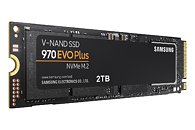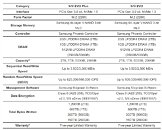Tuesday, January 22nd 2019

Samsung Launches the 970 EVO Plus NVMe SSD Family
Samsung today introduced the Samsung 970 EVO Plus, the newest enhancement in its Non-Volatile Memory Express (NVMe) SSD portfolio. With industry-leading performance and up to two terabytes in capacity, Samsung's 970 EVO Plus sets a new bar for high-performance storage, enabling IT professionals, tech enthusiasts and gamers to handle intensive workloads on PCs and workstations with more ease.
"Since introducing the first NVMe SSDs to the consumer market in 2015, Samsung has continued to challenge technical barriers in SSD design and performance," said Dr. Mike Mang, vice president of Brand Product Marketing, Memory Business at Samsung Electronics. "The new 970 EVO Plus powered by Samsung's latest fifth-generation V-NAND technology will now offer unrivaled performance in its class when taking on demanding tasks like 4K content editing, 3D modeling and simulation as well as heavy gaming."By integrating the company's most advanced V-NAND chips with optimized firmware, the 970 EVO Plus achieves significant performance improvements - up to 53 percent in write speed - as well as increased power efficiency over its predecessor, the 970 EVO. The new drive delivers sequential read and write speeds of up to 3,500 megabytes per second (MB/s) and up to 3,300 MB/s, respectively, while random speeds come in at up to 620,000 IOPS for read and up to 560,000 IOPS for write operations.
Users can easily upgrade their devices as the 970 EVO Plus comes in a compact M.2 form factor using the PCIe Gen3 x4 interface found in most modern computers. The 970 EVO Plus also offers a five-year limited warranty or up to 1,200 terabytes written.
The 970 EVO Plus comes in a variety of capacity options; the 250 GB, 500 GB and 1 TB capacity versions are now available for purchase worldwide, and the 2TB capacity will become available in April.
"Since introducing the first NVMe SSDs to the consumer market in 2015, Samsung has continued to challenge technical barriers in SSD design and performance," said Dr. Mike Mang, vice president of Brand Product Marketing, Memory Business at Samsung Electronics. "The new 970 EVO Plus powered by Samsung's latest fifth-generation V-NAND technology will now offer unrivaled performance in its class when taking on demanding tasks like 4K content editing, 3D modeling and simulation as well as heavy gaming."By integrating the company's most advanced V-NAND chips with optimized firmware, the 970 EVO Plus achieves significant performance improvements - up to 53 percent in write speed - as well as increased power efficiency over its predecessor, the 970 EVO. The new drive delivers sequential read and write speeds of up to 3,500 megabytes per second (MB/s) and up to 3,300 MB/s, respectively, while random speeds come in at up to 620,000 IOPS for read and up to 560,000 IOPS for write operations.
Users can easily upgrade their devices as the 970 EVO Plus comes in a compact M.2 form factor using the PCIe Gen3 x4 interface found in most modern computers. The 970 EVO Plus also offers a five-year limited warranty or up to 1,200 terabytes written.
The 970 EVO Plus comes in a variety of capacity options; the 250 GB, 500 GB and 1 TB capacity versions are now available for purchase worldwide, and the 2TB capacity will become available in April.


57 Comments on Samsung Launches the 970 EVO Plus NVMe SSD Family
If you only have 1 gfx card in your machine (as an example) on a chip with 16 lanes you get x8 for the GPU and still have the ability to have two other x4 M.2s in the other slot (if the UEFI supports PCIE splitting).
Back to TR, with one GPU you could have 9 or more in RAID running full speed (if the CPU/software can keep up is then the bottleneck, probably).
Agreed that PCIe 4.0 is a good thing to get though, it can allow more drives for the same lanes. x8 M.2 is less likely to happen IMO, not that I wouldn't welcome PCIe 4.0 x8 drives if affordable; 14GB/second from a single drive would be rather nice. ;)
My intel 4th and 6th gen systems booted in <5 seconds, my ryzens all take longer
It really does come down to the mobo's UEFI implementation, and it seems intel have an advantage there
www.purepc.pl/pamieci_masowe/test_dysku_samsung_ssd_970_plus_nowe_pamieci_nowa_energia?page=0,8 1x7GB file
www.purepc.pl/pamieci_masowe/test_dysku_samsung_ssd_970_plus_nowe_pamieci_nowa_energia?page=0,7 4GB worth of small files
but software installation times are so underwhelming
www.purepc.pl/pamieci_masowe/test_dysku_samsung_ssd_970_plus_nowe_pamieci_nowa_energia?page=0,13
www.purepc.pl/pamieci_masowe/test_dysku_samsung_ssd_970_plus_nowe_pamieci_nowa_energia?page=0,14
In practice,that is in real world testing like installation/loading times,all of the below:
adata sx8000
adata sx8200
plextor m9 (or even the old m8 one)
hp ex920
wd black 2018
sandisk extreme pro
intel 760p
are either as good or even better than 970 evo/evo plus at a lower price,in some cases like adata/hp considerably lower price.
Now I just wish HP would start selling their NVMe drives in Norway, as they look so good for the price.
I'm actually thinking of replacing my old 32gb usb flash drive with a 240gb ssd and putting it in a small,slick external enclosure.
this looks great,compact and fast,I never thought of getting an external msata drive
otherwise a bigger 1tb value-friendly nvme
if you're looking for bigger drives check out the prices on hp ex920,sx8200,wd black 2018,wd sn750,plextor m8 and m9,intel 760p first.sammys are great,I own three 850 pro's and a 860 evo myself,but they cost a premium. I got two adata drives recently,they both cost noticeably less than the samsung counterparts,and they perform as good.
perhaps if i go 970pro 1tb and move games/software over, that would make a difference?
no,you wouldn't see a difference.I'd perfer your setup over a single 970. 950 pro is as good or a better drive than 970 evo. 850 pro has stupendously long warranty.
look at real wold tasks, 950 pro whips 970 evo. 970 evo is an amazing drive but once the turbo cache buffer wears out the performance drop is significant.
www.purepc.pl/pamieci_masowe/test_dysku_samsung_ssd_970_plus_nowe_pamieci_nowa_energia?page=0,13
From what I understand, Samsung is on the expensive side in the US (here in Norway, they're usually cheaper than WD or ADATA, and HP don't even sell SSDs here) - if so, I would go for whatever gives you 1TB the cheapest among the WD Black, EX920 or SX8200, as they should all perform comparably.
As for exceeding the turbo cache - when does a consumer workload ever write 12GB+ continuously at such a speed that the controller can't shuffle it over to TLC during the transfer? Say we have a Steam install, which downloads, decompresses and installs continuously - given a 1.25x compression ratio for the download (which is likely), you'd need a 22,4 gigabit internet connection to max out a 3500MB/s drive. Given that >10GBE networking doesn't exist outside of datacenters, I kind of doubt that's an issue. If the write speed is in the hundreds of MB/s, the controller will shuffle data out as needed, and the cache will never fill. And for anything else, as in normal desktop usage, the biggest writes you'll ever see are in the low hundreds of MB (large save files, downloads, huge PDFs, etc.), and you'll be limited in nearly all cases by something else than your SSD. Mixed read/write workloads can choke drives, but only if they're heavy and sustained, which is again exceedingly rare in consumer usage. And, of course, the difference is usually in the <1s range if we're talking transferring files, unzipping, or something like that. You'll likely be bottlenecked elsewhere no matter what. And you'd never, ever notice the difference between any of these cheaper drives and a 970 Pro unless you have very specific demands. You might notice the difference between cheap x2 NVMe drives, but outside of really crappy ones, even that's not very likely for the average enthusiast user.